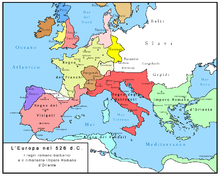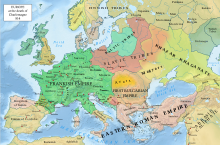Barbarian kingdoms
This article needs additional citations for verification. (September 2016) |




The barbarian kingdoms were kingdoms founded by various Germanic, Iranian, Hunnic and other peoples, that were established all over the Mediterranean after the Barbarian Invasions from the late antiquity to the early middle ages.[citation needed] The term "barbarian" has been commonly used by historians. Other terms used include "Northern European kingdoms", "Romano-northern European kingdoms",[2] and "post-Roman kingdoms".
Time frames[]
Historically, the period of the Barbarian kingdoms spans the years from 409 to c.800.[citation needed] It begins in 409 with several Barbarian kingdoms being established on the Iberian peninsula, including the Kingdom of the Suebi, the Alani Kingdom, and territories of Hasdingi and the Silingi Vandals.[citation needed] It ends with the formation of the Carolingian Empire in Western Europe.[citation needed]
Kingdoms[]
The most important and most successful of these kingdoms was that of the Franks. Established in the 4th to 5th century, the Frankish kingdom grew to include much of Western Europe, developing into the early medieval Carolingian Empire and ultimately the Kingdom of France and the Holy Roman Empire of the high medieval period and beyond. The Frankish Realm continued until 843, when it was partitioned. Realms resulting from this event included West Francia (predecessor of modern France), Middle Francia and East Francia (predecessor of modern Germany).
Other major kingdoms included those of the Visigoths and Ostrogoths; both were established in the 5th century. The Ostrogothic kingdom was re-conquered by the Eastern Roman Empire in the 550s, while the Visigothic kingdom survived into the 8th century, but finally fell to the Muslim invasion of Hispania. The kingdoms of the Burgundians and of the Suebi were established in the early 5th century, and fell to the Franks and the Visigoths, respectively, in the 6th century.The Alemannic Kingdom was established in the 3rd century; it became a duchy subject to the Franks in 496, although this overlordship was at times nominal and Alemannia remained semi-independent until the 8th century. The Vandal Kingdom existed in Africa and Sicily from 435 until 534. The romanized berbers established the Mauro-Roman Kingdom and other minor polities in Africa, lasting until the Muslim conquest.
Various Anglo-Saxon kingdoms existed in medieval England, after a mass settlement in the area. The Romano Britons and various celtic peoples established their own kingdoms in the same period all over Britain, Brittany and Ireland.
In Pannonia, the Huns established a short lived nomadic empire ruled by Attila. After them, the Gepids dominated the area. Finally another nomadic group, the Pannonian Avars established another nomadic empire in 567, lasting until the 9th century.
Another wave of barbarian invasors founded new kingdoms in the 6th century: The Kingdom of the Lombards in Italy was established in the 6th century and conquered by the Franks in 774. The Nomadic Bulgars established the First Bulgarian Empire in Thracia in 687. Meanwhile various Slavic groups like the Sclaveni and the Antes founded petty kingdoms in the Balkans in the same period.
Significance[]
The barbarian kingdoms marked the transition from Late Antiquity to the Early Middle Ages in the 6th and 7th centuries, gradually replacing the Roman system of government on the lands of the Western Roman Empire, notably in the two western prefectures of Gaul and Italy.[3]
These kingdoms were foederati of the Roman Empire and, even after the fall of the Western Roman Empire in AD 476, they continued - at least nominally - to consider themselves subject to the Eastern Emperor. These historical ties were weakened in the later 6th century, with the loss of many imperial possessions in the west under Justin II and the waning of the influence of an empire weakened by its wars with the Persians and the Arab invasion.
As a result, the "barbarian kingdoms" by the 7th to 8th centuries developed the system of feudalism characteristic of the European Middle Ages. The title of "emperor" was revived in the west by Charlemagne in AD 800. At the same time, the Carolingian Renaissance developed the notion of Europe as a geopolitical entity with a history separate from that of the wider Mediterranean region.
See also[]
- Early Middle Ages
- Byzantine Empire under the Justinian dynasty
- History of Europe
- Migration Period
- Dark Ages (historiography)
- Core Europe
- Germanic Europe
- Latin Church
- Late antiquity
- Germanic Christianity
- Germanic Heroic Age
- Romano-Germanic culture
- Timeline of Germanic kingdoms in the Iberian Peninsula
References[]
- ^ Michael Frassetto, The Early Medieval World: From the Fall of Rome to the Time of Charlemagne vol. 1 "Coins and Coinage", p. 203.
- ^ Chris Wickham, Framing the Early Middle Ages: Europe and the Mediterranean 400-800, Oxford (2005).
- ^ Kidner et al. (eds.), Making Europe: People, Politics, and Culture vol. 1 (2009), 198–203. J. Herrmann, E.- Zürcher (eds.), History of Humanity: From the seventh century B.C. to the seventh century A.D., UNESCO (1996), p. 255.
Further reading[]
- Walter Pohl (ed.), Kingdoms of the Empire: The Integration of Barbarians in Late Antiquity, BRILL (1997).
- Michael Frassetto, Encyclopedia of Barbarian Europe: Society in Transformation, ABC-CLIO (2003).
- Thomas F. X. Noble (ed.), From Roman Provinces to Medieval Kingdoms, Routledge (2006)
- Danuta Shanzer (ed.), Romans, Barbarians, and the Transformation of the Roman World: Cultural Interaction and the Creation of Identity in Late Antiquity, Routledge, (2016).
- Guy Halsall, Warfare and Society in the Barbarian West 450-900, Routledge (2008).
- Robert A. Markus "From Rome to the Barbarian Kingdoms (330–700)" in: John McManners (ed.), The Oxford Illustrated History of Christianity, OUP (2001), Oxford, 62–91.
- David Rollason, Early Medieval Europe 300-1050: The Birth of Western Society, Routledge (2014).
- Chris Wickham, Framing the Early Middle Ages: Europe and the Mediterranean 400-800, Oxford (2005).
External links[]
- Mike Markowitz, Ancient Coins: Coinage of the Barbarian Invaders, CoinWeek (8 September 2014)
- States and territories established in the 400s
- States and territories disestablished in the 8th century
- 6th century in Europe
- 7th century in Europe
- Barbarian kingdoms
- Former kingdoms
- Migration Period
